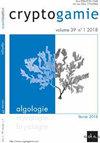Diversity and Distribution of Characeae in the Maghreb (Algeria, Morocco, Tunisia)
IF 1.5
4区 生物学
Q3 MARINE & FRESHWATER BIOLOGY
引用次数: 17
Abstract
Abstract Characeae are macroscopic green algae present in the Maghreb (Morocco, Algeria, Tunisia) that are known since the 19th century works of Desfontaines (1800) and Braun (1868). Feldmann (1946) published the first regional synthesis, and this study provides a new Maghreb-wide synthesis of all collections made since 1784 (570 observations distributed over 464 sites). Each of the 31 reported species is described in detail with its diagnostic features, ecology and distribution in the three Maghrebian countries. Distribution maps distinguish between the three collection periods: 1780–1939, 1940–1979, and 1980–2016. An illustrated key is provided to help botanists working in the Maghreb to identify the taxa. From a biogeographical perspective, the Characean flora of the Maghreb is dominated by elements originating from northern (European) countries (61.3%) that include regionally very rare species such as Chara strigosa and C. tomentosa. The Mediterranean-Atlantic element is also well represented (32.3%), with some Mediterranean endemics (Chara imperfecta, C. oedophylla, C. vulgaris var. gymnophylla). Finally, two taxa that have an affinity for tropical conditions (Chara zeylanica and Lamprothamnium succinctum) extend to the southern Sahara. In North Africa, 14 species (7 Chara, 2 Lamprothamnium, 4 Nitella and 1 Sphaerochara) are threatened and raise issues about their conservation; three of these are particularly endangered: Chara imperfecta, C. oedophylla and Lamprothamnium papulosum.马格里布地区(阿尔及利亚、摩洛哥、突尼斯)文字的多样性和分布
特征是存在于马格里布(摩洛哥,阿尔及利亚,突尼斯)的宏观绿藻,自19世纪Desfontaines(1800)和Braun(1868)的作品以来就已为人所知。Feldmann(1946)发表了第一个区域综合,这项研究提供了一个新的马格里布地区自1784年以来所有收集的综合(分布在464个地点的570个观测)。报告的31种中的每一种都详细描述了其诊断特征、生态和在三个马格里布国家的分布。分布图区分了三个收集时期:1780-1939年、1940-1979年和1980-2016年。为帮助在马格里布工作的植物学家识别分类群,提供了一个图解的钥匙。从生物地理学的角度来看,马格里布的特色植物区系主要由来自北欧(欧洲)国家的元素(61.3%)组成,其中包括区域内非常罕见的物种,如Chara strigosa和C. tomentosa。地中海-大西洋元素也有很好的代表(32.3%),有一些地中海特有的植物(Chara imperfecta, C. oedophylla, C. vulgaris变种裸子植物)。最后,两个与热带环境有亲缘关系的分类群(Chara zeylanica和lamprothamum succinctum)延伸到撒哈拉沙漠南部。在北非,14种(7种Chara, 2种lamprothamium, 4种Nitella和1种Sphaerochara)受到威胁,并提出了保护问题;其中三种特别濒临灭绝:不完美Chara imperfecta, C. oedophylla和lamprothamum papulosum。
本文章由计算机程序翻译,如有差异,请以英文原文为准。
求助全文
约1分钟内获得全文
求助全文
来源期刊

Cryptogamie Algologie
生物-海洋与淡水生物学
CiteScore
2.60
自引率
7.70%
发文量
11
审稿时长
>12 weeks
期刊介绍:
Cryptogamie is a fast-track and peer-reviewed journal of international scope publishing in English only. It accepts original papers and review articles on the taxonomy, biology and ecology of all cryptogams. An issue of Cryptogamie may be devoted to a single topic, under the responsibility of guest editor(s). All articles published in Cryptogamie are compliant with the different nomenclatural codes. A copyright assignment will be signed by the authors before publication.
Cryptogamie, Algologie accepts articles on systematics as well as ecology and evolution of any kind of algae (including Cyanobacteria).
 求助内容:
求助内容: 应助结果提醒方式:
应助结果提醒方式:


